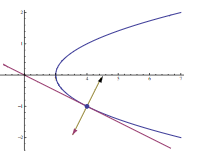Calculus III Advanced (Course) (13.6) (Homework)
Contents
Section 13.6 Homework
From Calculus 10e by Larson and Edwards, p. 924. Exercises 2, 24, 36, 52, 61
Exercise 13.6.2 Finding a Directional Derivative
Use Theorem 13.6.1 to find the directional derivative for the function at \(P\) in the unit vector \( \textbf{u} = \cos \theta \textbf{i} + \sin \theta \textbf{j} \)'s direction.
- $$ f(x,y) = \frac{y}{x+y} , \: P(3,0), \: \theta = - \frac{\pi}{6} $$
Solution
- $$ f_{x}(x,y) = -\frac{y}{(x+y)^{2}} $$
and
- $$ f_{y}(x,y) = \frac{x}{(x+y)^{2}} $$
- $$D_{\textbf{u}} (3,0) = -\frac{0}{(3+0)^{2}} \cos \left(- \frac{\pi}{6} \right) + \frac{3}{(3+0)^{2}} \sin \left( - \frac{\pi}{6} \right) = \left( \frac{1}{3} \right) \left( -\frac{1}{2} \right) = - \frac{1}{6}$$
Exercise 13.6.24 Finding a Directional Derivative Using the Gradient
Use the gradient to find the directional derivative for the function at \(P\) in the direction of \(Q\).
- \( f(x,y) = 3x^{2}-y^{2}+4\), \(P(-1,4)\), \(Q(3,6)\)
Solution First, find the gradient
- \( f_{x}(x,y) = 6x\)
and
- \( f_{y}(x,y) = -2y\)
- \(\nabla f(x,y) = 6x\textbf{i} -2y \textbf{j} \)
at the point \(P(-1,4)\)
- \(\nabla f(x,y) = -6\textbf{i} -8 \textbf{j} \)
Now find the unit vector.
- \( \vec{PQ} = (3+1)\textbf{i} + (6-4)\textbf{j} = 4 \textbf{i} + 2\textbf{j} \)
- $$\textbf{u} = \frac{4}{\sqrt{20}} \textbf{i} + \frac{2}{\sqrt{20}}\textbf{j} $$
- $$ D_{\textbf{u}}(-1,4) = (-6\textbf{i} -8 \textbf{j} ) \cdot \left( \frac{4}{\sqrt{20}} \textbf{i} + \frac{2}{\sqrt{20}}\textbf{j} \right) = -\frac{4}{\sqrt{5}} $$
Exercise 13.6.36 Using Gradient Properties
Find the gradient for the function and the maximum value for the directional derivative at the given point.
- \(f(x,y,z) = xe^{yz}, \: (2,0,-4)\)
Solution Find the partials
- \( f_{x}(x,y,z) = e^{yz} \)
- \( f_{y}(x,y,z) = zxe^{yz} \)
- \( f_{z}(x,y,z) = yxe^{yz} \)
- \( \nabla f(x,y,z) = e^{yz}\textbf{i} + zxe^{yz} \textbf{j} + yxe^{yz} \textbf{k} \)
- \( \nabla f(2,0,-4) = e^{(0)(-4)}\textbf{i} + (-4)(2)e^{(0)(-4)} \textbf{j} + (0)(2)e^{(0)(-4)} \textbf{k}= 1\textbf{i} -8 \textbf{j} + 0\textbf{k} = \sqrt{65} \)
Exercise 13.6.52 Using a Function
(a) Find the gradient for the function at \(P\).
(b) Find a unit normal vector to the level curve at \(f(x,y) = c\) at \(P\).
(c) Find the tangent line to the level curve \(f(x,y) = c\) at \(P\).
(d) Sketch the level curve, the unit normal vector, and the tangent line in the \(xy\)-plane.
- \(f(x,y) = x-y^{2} \), \(c=3\), and \(P(4,-1)\)
Solution
(a) First, find the partials
- \(f_{x}(x,y) = 1\)
- \(f_{y}(x,y) = -2y\)
yields
- \( \nabla f(x,y) = \textbf{i} -2y \textbf{j} \:\:\:\: \)Gradient
- \( \nabla f(4,-1) = \textbf{i} -2(-1) \textbf{j} = \textbf{i} +2 \textbf{j} = \langle 1,2 \rangle \:\:\:\: \)Gradient at \(P\)
(b)
- $$ \textbf{u} = \frac{1}{\sqrt{5}} \textbf{i} + \frac{2}{\sqrt{5}}\textbf{j} $$
(c)
- \( \langle 1,2 \rangle \cdot \langle x-4, y+1 \rangle = 0 \rightarrow x+2y=2 \)
(d)
Exercise 13.6.61 Topography
A mountain surface is described by the equation
- \(h(x,y) = 5000 - 0.001x^{2} - 0.004y^{2} \)
A mountain climber is at the point \((500,300,4390)\). In what direction should the climber move in order to ascend at the greatest rate?
Solution Find the increase at the maximum rate.
| \( \nabla h(x,y,z) \) | \(= h_{x}(x,y,z)\textbf{i} + h_{y}(x,y,z)\textbf{j} +h_{z}(x,y,z)\textbf{k} \) |
| \(= -0.002x\textbf{i} -0.008y\textbf{j}\) | |
| \( \nabla h(500,300,4390) \) | \(= -0.002(500)\textbf{i} -0.008(300)\textbf{j}\) |
| \( = -1\textbf{i} -2.4\textbf{j} = \langle -1, -2.4 \rangle \) |
Gradient vector is
- $$\textbf{u} = \frac{\nabla h}{ \| \nabla h \|} = \frac{\langle -1, -2.4 \rangle}{ \sqrt{6.76}} \approx \langle -0.38, -0.92 \rangle $$
Internal Links
Parent Article: Calculus III Advanced (Course)
